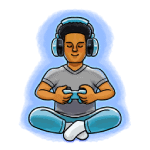Combating a Sedentary Lifestyle with Simple Moves
Having been a gameaholic and working in the game industry for over 12 years, I know what it’s like to lead a sedentary lifestyle, sometimes spending 80+ hours a week in front of a computer. After leaving high school, where I was active and fit, I gradually fell into the convenience of overindulging in junk food, gaming, and screen time. Even if you’re going to the gym or taking a morning jog, sitting for most of the day is comparable to being a heavy smoker in terms of health risks. Our bodies need to move throughout the day. So whether you’re gaming for hours or working at a desk and then hitting the gym for an hour, it can still lead to a sedentary lifestyle. Long periods of sitting can negatively impact your health, even if you’re active for an hour each day. 🤔
Table of Contents
The Sedentary Trap
 Despite incorporating exercise into daily routines, many people fall into what’s known as the “sedentary trap.” Hours of uninterrupted sitting at work or during gaming sessions can counteract the benefits of scheduled physical activities like going to the gym. This imbalance can lead to a condition often referred to as “Active Sedentary Lifestyle“ aka. “Active Couch Potatoes“, which is characterized by being physically active for short periods but predominantly sedentary the rest of the time.
Despite incorporating exercise into daily routines, many people fall into what’s known as the “sedentary trap.” Hours of uninterrupted sitting at work or during gaming sessions can counteract the benefits of scheduled physical activities like going to the gym. This imbalance can lead to a condition often referred to as “Active Sedentary Lifestyle“ aka. “Active Couch Potatoes“, which is characterized by being physically active for short periods but predominantly sedentary the rest of the time.
Prevalence of Sedentary Behavior: According to numerous studies, including those published by the American Journal of Epidemiology, a significant portion of the average person’s day in Western countries is spent in sedentary activities, and some studies indicate that more than half of the waking hours are spent in sedentary behaviours such as sitting. Even among those who exercise regularly, it is common to spend extended periods seated, particularly in office settings or during long commutes.
Health Consequences of an Active Sedentary Lifestyle
⚖️ Metabolic Dysfunction:
Long periods of sitting reduce the activity of lipoprotein lipase, an enzyme crucial for breaking down fats in the bloodstream, potentially leading to metabolic disorders.
💪 Musculoskeletal Issues:
Extended time at desks or gaming stations can cause muscle weakness, particularly in the lower body and core,
contributing to poor posture and increased risk of injury.
🧠 Cognitive Decline:
Research suggests that sedentary behaviour, even in active individuals, may be linked to cognitive decline and an increased risk of dementia.
😔 Mental Health:
An active sedentary lifestyle is associated with higher rates of depression and anxiety, despite regular exercise.
Strategies to Combat the Active Sedentary Lifestyle
⏰🚶♂️Movement Breaks:
Every hour, take a 5-minute walk. If possible, step outside to get some sun and focus on distant objects to give your eyes a break from screens and some exercise.
💬 Walk and Talk Sessions:
Planning a strategy? Have a meeting? Do it on the move! A walking meeting can enhance creativity, as walking boosts blood flow to the brain, aiding clearer thinking and keeping those gamer reflexes sharp. Plus, you’ll burn extra calories!
💻 Deskercises:
Boost Your Health Without Leaving Your Chair, see more below about Deskercises, Stretches and Fidgeting.
🚶♀️ Choose Challenge Over Convenience:
Take the stairs instead of the elevator, walk a bit further for lunch or coffee, or park a little farther from the store. It’s an easy way to sneak in cardio and strengthen your legs. Explore your realm and don’t settle for convenience.
📱 Screen Time Management:
Set limits on recreational screen time and incorporate active breaks during work or gaming sessions.
👥 Social Support:
Engage colleagues, fellow gamers, friends, or family in active pursuits to make movement more enjoyable and sustainable.
💧 Stay Hydrated:
Keep a water bottle by your gaming setup. Adding a pinch of Celtic Salt can help with better hydration absorption. Drink in small sips to stay hydrated without frequent breaks. Snack on fruit for an extra hydration boost—they’re nature’s water bottles!
😴 Sleep Hygiene:
Prioritize good sleep habits, as poor sleep can contribute to sedentary behaviour during waking hours, even for those who exercise.
🧠 Level Up Your Brain’s Resilience:
Engaging in activities outside your comfort zone, including those you may not initially enjoy, can strengthen your brain’s resilience. Facing and overcoming such challenges can help develop mental flexibility, improve problem-solving skills, and enhance your ability to adapt to new situations. This process is known as cognitive and emotional stretching, which contributes to overall psychological resilience.
Keep moving, stay hydrated, and let’s game our way to a healthier life! 🎮🏃♂️💧
Deskercises and Micro-Movements
Even when tied to your desk or gaming setup, you can incorporate subtle exercises and movements to combat the negative effects of prolonged sitting. Here are some creative ways to stay active:
🦵 Leg Lifts and Circles: While seated, extend one leg and hold it straight for 10 seconds. Then, draw circles with your foot. Repeat with the other leg.
💪 Desk Push-Ups: Place your hands shoulder-width apart on the edge of your desk and lower your chest towards the desk, then push back up.
🧘♀️ Chair Yoga: Try seated twists, cat-cow stretches, or ankle-to-knee poses to improve flexibility and reduce tension.
🏋️ Resistance Band Workouts: Keep a resistance band at your desk for bicep curls, shoulder presses, or leg extensions.
🪑 Seated Marches: Lift your knees alternately as if marching in place while seated.
👐 Hand and Wrist Exercises: Practice finger spreads, wrist rotations, and hand squeezes to prevent repetitive strain injuries.
😮 Facial Exercises: Incorporate face yoga or jaw releases to relieve tension and improve circulation in your face.
Micro-Movements Matter
Don’t underestimate the power of fidgeting and small movements. Research suggests that these non-exercise activity thermogenesis (NEAT) movements can significantly impact your overall health:
👣 Foot Tapping: A simple way to keep blood flowing in your lower extremities.
🎾 Stress Ball Squeezes: Great for relieving tension and working your forearms.
🔄 Desk Swiveling: Gentle rotations in your chair can engage your core muscles.
🖇️ Fidget Toys: Using small desk toys can help maintain focus and burn a few extra calories.
🙆♀️ Stretching: Periodic stretches, even while seated, can help maintain flexibility and reduce muscle tension.
These micro-movements can:
- Increase blood circulation
- Slightly boost calorie burn (up to 350 kcal per day)
- Enhance focus and productivity
- Reduce stress and anxiety
- Improve overall physical and mental well-being
Remember, every movement counts! By integrating these exercises and micro-movements into your daily routine, you can mitigate some of the negative effects of prolonged sitting.
Conclusion
While regular exercise is crucial for health, it’s equally important to reduce overall sedentary time throughout the day. The Active Sedentary Lifestyle paradox highlights that even those who exercise regularly can face health risks from prolonged sitting. By implementing these strategies and remaining conscious of sitting time – whether at work, gaming, or relaxing – individuals can mitigate the risks associated with sedentary lifestyles and improve their overall health and well-being. Remember, it’s not just about being active for an hour a day, but about moving regularly throughout your waking hours! 💪🕒
You Create You!
Author:
 |
Lionel Thomas Father, Gamer and Founder with a Passion for Health, AI, Environment and Gamification of Life. |
Author Tools:
- ChatGPT (Content Enhancements & Research)
- Claude (Content Enhancements & Research)
- ElevenLabs (Audio by AI)
- GSpeech (Audio by AI)
- Other Tools (AI)...
Artists:
- Lionel Thomas using Leonardo.ai [AI Generated] (Header, Content)
References:
-
1. Sedentary Lifestyle: Overview of Updated Evidence of Potential Health Risks
National Library of Medicine
https://www.ncbi.nlm.nih.gov/pmc/article...
Summary:
A sedentary lifestyle, characterized by long hours of sitting and low physical activity, is linked to significant health risks, including increased all-cause mortality, cardiovascular diseases, diabetes, cancer, and metabolic disturbances like dyslipidemia and hypertension. Despite the global prevalence of sedentary behaviors—averaging 7.7 to 8.3 hours daily in adults in the U.S. and South Korea—many remain unaware of the severe implications. These behaviors diminish lipoprotein lipase activity and impair glucose and lipid metabolism, leading to reduced insulin sensitivity and altered hormonal levels, which in turn increase the risk of hormone-related cancers. Moreover, sedentary habits contribute to musculoskeletal issues, mental health challenges like depression, and cognitive impairments. Therefore, integrating regular physical activity, breaking up long periods of sitting with movement, and optimizing active periods can mitigate these health risks, emphasizing the importance of both reducing sedentary time and enhancing physical activity levels.
-
2. Inactivity and a sedentary lifestyle
Heart Research Institute
https://www.hri.org.au/health/learn/risk...
Summary:
Quote "Up to 5 million deaths could be averted globally every year if people were more active."
-
3. The Normalization of the “Active-Sedentary” Lifestyle in Spanish Youth
Scientific Research
https://www.scirp.org/html/2-2290203_482...
Summary:
The study "Normalization of the 'Active-Sedentary' Lifestyle in Spanish Youth" reveals a significant cultural shift towards sedentary behaviors among young Spaniards, despite being perceived as "active" due to engaging in various non-physical activities. It highlights a paradox where physical activity levels are not increasing correspondingly with the perception of being active. The research shows that young adults differentiate between being busy with multiple daily activities and genuinely engaging in physical activities and sports, which are essential for maintaining health. The study stresses the need for structural sports policies targeting the primary institutions of socialization like families, schools, and media to counteract this trend. It suggests that breaking the cycle of sedentary habits requires a holistic approach, emphasizing the importance of early socialization into physical activity to foster long-term health and well-being.
-
4. Potential Effects on Mortality of Replacing Sedentary Time With Short Sedentary Bouts or Physical Activity: A National Cohort Study
American Journal of Epidemiology | Oxford Academic
https://academic.oup.com/aje/article/188...
Summary:
The study titled "Potential Effects on Mortality of Replacing Sedentary Time With Short Sedentary Bouts or Physical Activity: A National Cohort Study" conducted by Keith M Diaz and others, published in the American Journal of Epidemiology in 2019, explored the health impacts of replacing sedentary behavior with physical activity. Using data from a national cohort of US adults, the study utilized isotemporal substitution techniques to analyze how replacing total sedentary time and prolonged sedentary bouts with light-intensity physical activity (LIPA) or moderate to vigorous physical activity (MVPA) affects all-cause mortality risk.
Key findings include:
Reduction in Mortality Risk: Replacing 30 minutes of total sedentary time with 30 minutes of LIPA was associated with a 17% reduction in mortality risk, and replacing it with MVPA resulted in a 35% reduction.
Impact of Sedentary Bout Duration: Shortening prolonged sedentary bouts (defined in the study as sedentary periods lasting ≥30 minutes) with periods of LIPA or MVPA also showed beneficial associations with mortality risk, whereas simply replacing them with shorter sedentary bouts did not significantly impact mortality risk.
Activity Levels and Mortality Benefits: The study also noted that the mortality benefits from replacing sedentary time with physical activity varied depending on an individual’s overall activity levels. Less-active adults gained more significant health benefits compared to those who were already more active.
This study emphasizes the importance of not only increasing physical activity but also strategically reducing and interrupting sedentary time to improve health outcomes. It suggests that interventions aimed at reducing sedentary behavior should include promoting both light and more vigorous forms of physical activity, tailored to individual activity levels to maximize health benefits.
-
5. Sedentary behaviour and disease risk
BMC Public Health
https://bmcpublichealth.biomedcentral.co...
Summary:
Sedentary behaviour, defined as waking time spent sitting or lying with low energy expenditure, has become widespread in modern society and is linked to the rise of various chronic diseases, such as type 2 diabetes, cardiovascular disease, and obesity. This paper highlights the current evidence and proposes topics for a BMC Public Health collection on "Sedentary Behaviour and Disease Risk."
Key Points:
Definition and Prevalence: Sedentary behaviour is distinguished from physical inactivity and is prevalent across different environments, occupying up to 80% of waking hours.
Health Risks: Increased sedentary behaviour is associated with higher risks of chronic diseases and premature mortality. For instance, sitting for more than 9.5 hours a day significantly increases the risk of all-cause mortality.
Research and Guidelines: While research on physical activity has been extensive, studies on sedentary behaviour are relatively new but growing. Recent global guidelines emphasize reducing sedentary time and replacing it with physical activity.
Epidemiological Evidence: A dose-response relationship exists between sedentary time and mortality. Breaking prolonged sitting with light activities can improve cardiometabolic health.
Interventions and Public Health: Effective interventions to reduce sedentary behaviour are needed. These should be multi-component and context-specific, addressing both individual and environmental factors. Successful examples include workplace interventions with adjustable desks.
Future Directions: The collection seeks high-quality, multidisciplinary research on sedentary behaviour and chronic diseases, public awareness campaigns, and interventions tailored to various contexts and populations.
This comprehensive overview underscores the importance of addressing sedentary behaviour to mitigate the risk of chronic diseases and improve public health outcomes.
-
6. Study shows benefits of exercise dependent on hours spent sitting
Medical X press
https://medicalxpress.com/news/2023-08-b...
Summary:
A comprehensive review titled "Physiology of Sedentary Behavior," published in Physiological Reviews, highlights the need to reduce sedentary time and increase physical activity for better health outcomes.
Key Points:
Interconnected Health Risks: Sedentary behavior is associated with health risks such as high blood pressure, increased body fat, poor vascular function, and elevated blood glucose and insulin levels.
Holistic Approach: The review suggests that public health guidelines should go beyond promoting physical activity alone and should advocate for less sitting, more movement, and exercise.
Influence of Sedentary Time: The health benefits of physical activity are diminished by prolonged sitting. For instance, a jog after a day of sitting provides fewer benefits due to the accumulated sedentary time.
Practical Implications: Professor David Dunstan emphasizes the importance of incorporating the question "How much time do you spend sitting?" into discussions about physical activity with GPs and primary health providers. This approach can better identify health risks and guide interventions.
Breaking Up Sitting Time: Regularly interrupting sitting time with movement can restart muscle activity and reduce health risks. The focus should be on reducing sitting time as a starting point for becoming more active.
Health Care Practice: The review aims to embed an evidence-based risk identification matrix into health care practice, showing the inextricable link between physical activity and sedentary behavior and their combined impact on health.
Overall, the study calls for a more integrated approach to health guidelines, emphasizing the reduction of sedentary behavior alongside increasing physical activity to mitigate health risks.








 Snacks
Snacks Water
Water Eye Sight
Eye Sight Hearing
Hearing
































